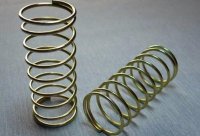弹簧受力压缩的原理与应用
弹簧是我们生活中常见的物体,也是物理学中一个重要的概念。弹簧受力压缩是指当外力作用在弹簧上时,弹簧会发生变形,压缩的程度与受力的大小成正比。了解弹簧受力压缩的原理,可以帮助我们更好地理解弹簧的应用和工作原理。
弹簧受力压缩的原理可以通过胡克定律来解释。胡克定律是指弹簧的形变与受力之间存在线性关系,即弹簧的变形量与受力成正比。这意味着弹簧的受力压缩可以通过数学公式来计算。胡克定律的数学表达式为:
F = -kx
其中,F代表受力的大小,k代表弹簧的弹性系数,x代表弹簧的变形量。这个公式告诉我们,当受力增大或弹性系数增大时,弹簧的变形量也会增加。
弹簧受力压缩的应用非常广泛。在工程领域中,弹簧常被用作机械装置中的重要组件。例如,汽车避震器中的弹簧可以减少车辆行驶中的震动,提供更平稳的行驶体验。弹簧也常用于工业机械中的减振装置和保护装置,起到缓冲和保护的作用。
在电子设备中,弹簧也扮演着重要的角色。手机中的摄像头防抖动结构就包含了弹簧。当手机发生震动时,弹簧可以通过受力压缩来减少摄像头的晃动,从而提高拍摄效果。此外,弹簧还广泛应用于打印机中的纸张进纸机构,电磁锁中的锁舌等。
在生活中,我们也经常接触到弹簧。家用门的门闩机构中常常使用弹簧,可以确保门闩的顺利打开和关闭。固定夹子、弹簧床垫、笔筒等物品中也会用到弹簧。可以说,弹簧已经深入到我们的日常生活中的方方面面。
弹簧受力压缩有一些实际注意事项需要我们注意。首先,弹簧受力压缩时要注意受力的方向和受力的点。受力方向决定了弹簧的变形方向,受力点的位置决定了变形的程度。其次,弹簧在受力压缩时要保持弹性恢复力,即在受力解除后能够恢复原状。如果弹簧失去了弹性恢复力,可能需要更换或修复。
总结起来,弹簧受力压缩是一个基于胡克定律的物理现象,具有重要的应用价值。了解弹簧受力压缩的原理和应用,有助于我们更好地理解弹簧的工作原理,以及在工程和生活中的应用。弹簧作为一种常见的弹性物体,其受力压缩的特点使其在各个领域具有广泛的应用前景。
In English: htmlPrinciple and Application of Spring Compression Under Force
Spring is a common object in our daily life and an important concept in physics. Spring compression under force refers to the deformation of the spring when an external force is applied on it, and the degree of compression is directly proportional to the magnitude of the force. Understanding the principle of spring compression under force helps us better understand the application and working principle of springs.
The principle of spring compression under force can be explained by Hooke's Law. Hooke's Law states that there is a linear relationship between the deformation of the spring and the force applied, meaning that the deformation of the spring is directly proportional to the force. This implies that the compression of the spring under force can be calculated using a mathematical formula. The mathematical expression of Hooke's Law is:
F = -kx
Where F represents the magnitude of the force, k represents the spring constant, and x represents the deformation of the spring. This formula tells us that as the force or spring constant increases, the deformation of the spring also increases.
The application of spring compression under force is widespread. In the field of engineering, springs are commonly used as important components in mechanical devices. For example, the springs in automotive shock absorbers reduce vibrations during vehicle travel, providing a smoother driving experience. Springs are also used in industrial machinery for vibration damping and protection, serving as cushioning and protective devices.
In electronic devices, springs also play a crucial role. The camera anti-shake structure in mobile phones, for instance, includes springs. When the phone experiences vibration, the springs compress under force to reduce the camera's shake, thus improving the image quality. Furthermore, springs are widely used in paper feeding mechanisms of printers, lock tongues in electromagnetic locks, and numerous other applications.
In daily life, we frequently encounter springs. Springs are commonly used in the latch mechanisms of household doors to ensure smooth opening and closing. They are also found in clips, spring mattresses, pen holders, and various other household items. Springs have essentially permeated every aspect of our daily lives.
There are some practical considerations to be aware of when dealing with spring compression under force. Firstly, it is important to pay attention to the direction and point of force application. The direction of force determines the direction of spring deformation, while the position of force application determines the degree of deformation. Secondly, springs should maintain their elastic restorative force when compressed under force, meaning they should return to their original shape after the force is released. If a spring loses its elastic restorative force, it may need to be replaced or repaired.
In conclusion, spring compression under force is a physical phenomenon based on Hooke's Law and holds significant practical value. Understanding the principles and applications of spring compression under force helps us comprehend the working principles of springs and their applications in engineering and daily life. As a common elastic object, springs offer broad prospects for applications in various fields due to their distinctive characteristics of compression under force.

 214
214 2023-08-14 21:07
2023-08-14 21:07 admin
admin

 1
1
